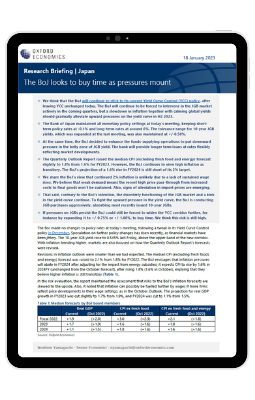The BoJ looks to buy time as pressures mount

The Bank of Japan maintained its monetary policy settings at today’s (18th Jan) meeting. At the same time, the BoJ decided to enhance the funds-supplying operations to put downward pressure in the belly zone of JGB yield. Meanwhile, revisions in inflation outlook were smaller than we had expected. We think that the BoJ will continue to stick to its current Yield Curve Control policy ahead. The BoJ will continue to intervene in the JGB market actively in the coming quarters, but a slowdown in inflation together with calming global yields should gradually alleviate upward pressures on the yield curve in H2 2023.
What you will learn:
- The Quarterly Outlook Report raised the median CPI (excluding fresh food and energy) forecast slightly to 1.8% from 1.6% for FY2023. However, the BoJ continues to view high inflation as transitory. The BoJ’s projection of a 1.6% rise in FY2024 is still short of its 2% target.
- We share the BoJ’s view that continued 2% inflation is unlikely due to a lack of sustained wage rises. We believe that weak demand means the recent high price pass-through from increased costs to final goods won’t be sustained. Also, signs of alleviation in import prices are emerging.
- That said, contrary to the BoJ’s intention, the disorderly functioning of the JGB market and a kink in the yield curve continue. To fight the upward pressure in the yield curve, the BoJ is conducting JGB purchases aggressively, absorbing most recently issued 10-year JGBs.
- If pressures on JGBs persist the BoJ could still be forced to widen the YCC corridor further, for instance by expanding it to +/-0.75% or +/-1.00%, to buy time. We think this risk is still high.
Tags:
Related Resouces

Post
Tariffs and Politics Leave the BoJ Powerless in Japan
The Bank of Japan kept its policy rate at 0.5% at its July meeting. We continue to think the BoJ will exercise caution on rate hikes despite still-high inflation and a recent trade deal with the US.
Find Out More
Post
US-Japan Trade Deal Fails to Shift Japan’s Growth Outlook
We estimate that the US's effective tariff rate on Japanese products is around 17%, in line with our baseline assumption. Lower tariffs on autos are a positive, given the sector's significant contribution to the economy and its broad domestic supporting base
Find Out More
Post
Japan’s Rising Political Instability Will Undermine Fiscal Discipline
The ruling Liberal Democratic party (LDP) and its partner Komeito lost their majority in Japan's upper house elections on July 20. Although Prime Minister Shigeru Ishiba will likely stay to avoid political gridlock, especially to complete tariff negotiations with the US, the political situation has become fluid and could lead to a leadership change or the reshuffling of the coalition.
Find Out More